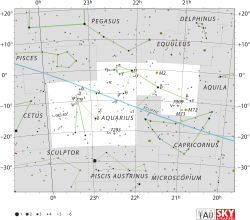Delta Aquarii

Location of δ Aquarii (circled) | |
| Observation data Epoch J2000 Equinox J2000 | |
|---|---|
| Constellation | Aquarius |
| Right ascension | 22h 54m 39.0125s[1] |
| Declination | −15° 49′ 14.953″[1] |
| Apparent magnitude (V) | 3.252[2] |
| Characteristics | |
| Spectral type | A3 V[3] |
| U−B color index | +0.172[2] |
| B−V color index | +0.068[2] |
| Astrometry | |
| Radial velocity (Rv) | +18.0[4] km/s |
| Proper motion (μ) | RA: -42.60[1] mas/yr Dec.: -27.89[1] mas/yr |
| Parallax (π) | 20.44 ± 2.26[1] mas |
| Distance | approx. 160 ly (approx. 49 pc) |
| Details | |
| Mass | 2.0[5] M☉ |
| Radius | 2.4[5] R☉ |
| Luminosity | 26[5] L☉ |
| Surface gravity (log g) | 3.66[6] cgs |
| Temperature | 9,000[6] K |
| Metallicity [Fe/H] | –0.15[6] dex |
| Rotational velocity (v sin i) | 81[7] km/s |
| Age | 0.3[8] Gyr |
| Other designations | |
| Database references | |
| SIMBAD | data |
Delta Aquarii (δ Aqr, δ Aquarii) is the third-brightest star in the constellation Aquarius. It has the traditional name Skat,[10] which has also been used for Beta Pegasi. The apparent visual magnitude is 3.3,[2] which can be seen with the naked eye. The distance to this star is estimated as 160 light-years (49 parsecs) based upon parallax measurements.[1]
Properties
The spectrum of Skat matches a stellar classification of A3 V,[3] indicating this is an A-type main sequence star that is generating energy through the nuclear fusion of hydrogen at its core. This star has double the Sun's mass and a radius 2.4 times as large.[5] It is radiating 26[5] times the luminosity of the Sun from its outer atmosphere at an effective temperature of around 9,000 K.[6] This heat gives it the characteristic white-hued glow of an A-type star.[11] It has a relatively high rate of rotation, with a projected rotational velocity of 81 km s−1.[7]
Delta Aquarii has been closely examined for a companion, but none has been discovered.[8] Nor does it display a strong signal of excess infrared emission that might indicate the presence of circumstellar matter.[12] Delta Aquarii is a probable stream star member of the Ursa Major Moving Group,[13] which has an estimated age of 500 million years.[14]
In culture
The traditional name has generally been thought to derive from the Arabic as-saq (الساق) "leg" or "shin"; however, the medieval forms Scheat, Seat, Sheat suggest it may be instead from the Arabic ši'at (شئت) "wish".
In Chinese, 羽林軍 (Yǔ Lín Jūn), meaning Palace Guard, refers to an asterism consisting of δ Aquarii, 29 Aquarii, 35 Aquarii, 41 Aquarii, 47 Aquarii, 49 Aquarii, λ Piscis Austrini, HD 212448, ε Piscis Austrini, 21 Piscis Austrini, 20 Piscis Austrini, υ Aquarii, 68 Aquarii, 66 Aquarii, 61 Aquarii, 53 Aquarii, 50 Aquarii, 56 Aquarii, 45 Aquarii, 58 Aquarii, 64 Aquarii, 65 Aquarii, 70 Aquarii, 74 Aquarii, τ2 Aquarii, τ1 Aquarii, 77 Aquarii, 88 Aquarii, 89 Aquarii, 86 Aquarii, 101 Aquarii, 100 Aquarii, 99 Aquarii, 98 Aquarii, 97 Aquarii, 94 Aquarii, ψ3Aquarii, ψ2Aquarii, ψ1Aquarii, 87 Aquarii, 85 Aquarii, 83 Aquarii, χ Aquarii, ω1 Aquarii and ω2 Aquarii. Consequently, δ Aquarii itself is known as 羽林軍二十六 (Yǔ Lín Jūn ershíliù, English: the Twenty Sixth Star of Palace Guard.)[15]
References
- ↑ 1.0 1.1 1.2 1.3 1.4 1.5 van Leeuwen, F. (November 2007), "Validation of the new Hipparcos reduction", Astronomy and Astrophysics 474 (2): 653–664, arXiv:0708.1752, Bibcode:2007A&A...474..653V, doi:10.1051/0004-6361:20078357
- ↑ 2.0 2.1 2.2 2.3 Celis S., L. (October 1975), "Photoelectric photometry of late-type variable stars", Astronomy and Astrophysics Supplement Series 22: 9–17, Bibcode:1975A&AS...22....9C
- ↑ 3.0 3.1 Houk, Nancy (1979), Michigan catalogue of two-dimensional spectral types for the HD stars 4, Ann Arbor, Michigan: Dept. of Astronomy, University of Michigan, Bibcode:1988MSS...C04....0H
- ↑ Wilson, Ralph Elmer (1953). General Catalogue of Stellar Radial Velocities. Washington: Carnegie Institution of Washington. Bibcode:[http://adsabs.harvard.edu/abs/1953QB901.W495..... 1953QB901.W495.....]
- ↑ 5.0 5.1 5.2 5.3 5.4 Malagnini, M. L.; Morossi, C. (November 1990), "Accurate absolute luminosities, effective temperatures, radii, masses and surface gravities for a selected sample of field stars", Astronomy and Astrophysics Supplement Series 85 (3): 1015–1019, Bibcode:1990A&AS...85.1015M
- ↑ 6.0 6.1 6.2 6.3 Hill, G. M. (February 1995), "Compositional differences among the A-type stars. 2: Spectrum synthesis up to V sin i = 110 km/s", Astronomy and Astrophysics 294 (2): 536–546, Bibcode:1995A&A...294..536H
- ↑ 7.0 7.1 Royer, F.; Zorec, J.; Gómez, A. E. (February 2007), "Rotational velocities of A-type stars. III. Velocity distributions", Astronomy and Astrophysics 463 (2): 671–682, arXiv:astro-ph/0610785, Bibcode:2007A&A...463..671R, doi:10.1051/0004-6361:20065224
- ↑ 8.0 8.1 Ehrenreich, D. et al. (November 2010), "Deep infrared imaging of close companions to austral A- and F-type stars", Astronomy and Astrophysics 523: A73, arXiv:1007.0002, Bibcode:2010A&A...523A..73E, doi:10.1051/0004-6361/201014763
- ↑ "del Aqr -- Star", SIMBAD (Centre de Données astronomiques de Strasbourg), retrieved 2012-01-30
- ↑ Allen, Richard Hinkley (1963), Star Names: Their Lore and Meaning, New York: Dover Publications, ISBN 0-486-21079-0
- ↑ "The Colour of Stars", Australia Telescope, Outreach and Education (Commonwealth Scientific and Industrial Research Organisation), December 21, 2004, retrieved 2012-01-16
- ↑ Su, K. Y. L. et al. (December 2006), "Debris Disk Evolution around A Stars", The Astrophysical Journal 653 (1): 675–689, arXiv:astro-ph/0608563, Bibcode:2006ApJ...653..675S, doi:10.1086/508649
- ↑ King, Jeremy R. et al. (April 2003), "Stellar Kinematic Groups. II. A Reexamination of the Membership, Activity, and Age of the Ursa Major Group", The Astronomical Journal 125 (4): 1980–2017, Bibcode:2003AJ....125.1980K, doi:10.1086/368241
- ↑ Monier, R. (November 2005), "Abundances of a sample of A and F-type dwarf members of the Ursa Major Group", Astronomy and Astrophysics 442 (2): 563–566, Bibcode:2005A&A...442..563M, doi:10.1051/0004-6361:20053222
- ↑ (Chinese) AEEA (Activities of Exhibition and Education in Astronomy) 天文教育資訊網 2006 年 7 月 7 日
External links
| ||||||||||||||||||||||||||